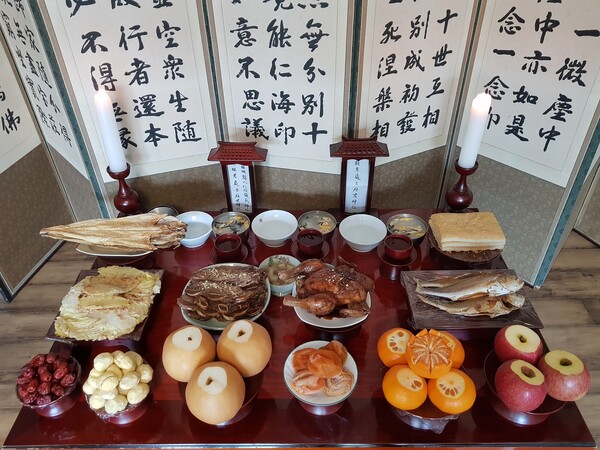
During Chuseok, roads in Korea become full of people heading to their hometowns to spend time with family. The highways are jammed with long lines of vehicles, and the bus and train stations are bustling with activity, running out of tickets. It is a moment of deep tradition for Koreans rather than just a simple trip. Chuseok, one of Korea’s most important holidays, falls on the 15th day of the eighth month in the lunar calendar, which usually corresponds to mid-September to early October. The origin of Chuseok is rooted in agricultural harvest festivals and has been an important holiday since the Goryeo and Joseon Dynasties. Chuseok features the brightest and fullest moon of the autumn season, a time to celebrate the harvest and express gratitude to ancestors. The holiday is filled with wishes for happiness and abundance. Through this article, The Dongguk Post would like to introduce the tradition of Chuseok.
There are various traditional customs and practices seen during Chuseok. Among them, The Dongguk Post would like to introduce some key aspects: charye, representative foods during Chuseok, and traditional games played during Chuseok
Chuseok customs: Charye
Charye is a traditional ritual that is held on the morning of Chuseok, which celebrates ancestors and honors their souls. Families gather together to perform the ritual, preparing a ceremonial table with a variety of traditional foods, fruits, and drinks. These traditional foods, fruits, and drinks are prepared as the meaning for to serve the ancestors’ soul to visit and enjoy the meals. During the charye, family members bow and express their gratitude to their ancestors while wishing for the well-being and happiness of their family. At the time of the ritual, the bowing is done twice with the front door open in order to honor the soul of the ancestors’ visit. During the bowing, the head of the family, who is bowing at the front, moves the spoon and chopsticks from the dish with food to another dish, serving the ancestors variety of foods.
In the past, it was standardized for families to prepare food at home according to traditional rules, with extended families coming together for the occasion. The arrangement and placement of the food on the ceremonial table were strictly regulated. Nowadays, the practice has evolved to accommodate busy lifestyles and changing family structures. It has become more practical and flexible, with many opting for professional services or pre-prepared sets. Furthermore, the foods that the ancestors enjoyed are also added these days like pizza, fried chicken or a coffee. Additionally, the food offered in charye is slightly different by region, reflecting the unique characteristics of each area in Korea.
Traditional Chuseok foods
Traditional Chuseok foods are well known and are prepared for family gatherings. One of the staple foods is songpyeon, a type of rice cake, typically shaped into round or half-moon forms and filled with ingredients like chestnuts, red beans, and sesame seeds to symbolize the abundance of autumn. The process of making songpyeon together allows families to come together and bond while passing down traditions.
Another remarkable Chuseok food is jeon, a savory pancake made from batter mix and eggs with various fillings. There are lots of kinds of jeon that differ from region to region. The most typical jeons are dongtae(cod)-jeon, hobak(pumpkin)-jeon, and kkochi(skewer)-jeon.
Galbijjim and japchae are also popular dishes. Galbijjim combines ribs with soy sauce seasoning, carrots, chestnuts, and jujubes to create a savory and sweet flavor, while japchae is glass noodles that are mixed with carrots, onions, spinach, mushrooms, and beef.
For dessert sikhye, a sweet drink made with rice and malt barley, and hangwa, traditional Korean sweets made from grain flour, honey, and seeds, are enjoyed by many people. There are many different types of hangwa, such as yugwa (fried rice cakes), dasik (pressed flour sweets), and yakgwa (honey cookies). These treats are also made with great care and tradition.
Traditional Chuseok activities
Traditional games and Chuseok activities are also significant parts of Chuseok. Ssireum, a conventional form of wrestling, involves men competing in strength and skill, originating as a ritual to wish for a successful harvest and fostering community spirit.
Ganggangsullae, a folk dance performed by women under the moonlight, involves joining hands in a circle to sing and dance, strengthening communal bonds, especially in the Jeollanam-do region where it originated. Yutnori, a board game using four sticks to determine the movement of pieces, combines play and divination, making it accessible to people of all ages and genders, thus enhancing family ties and community cohesion.
These days ssireum and ganggangsullae are not performed as much as they were in the past. However, these games and activities continue to be enjoyed today and are still organized as events by local organizations or municipalities, either in their traditional forms or through modern adaptations. This reinforces the festive spirit and cultural heritage of Chuseok.
Chuseok is one of Korea’s most significant traditional holidays, a time when families return to their hometowns to gather and express gratitude to their ancestors while celebrating the autumn harvest. International Donggukians can enjoy the Korean Chuseok cultures by visiting traditional market, the National Folk Museum, folk villages, and hanok villages. Although many restaurants and facilities close on Chuseok Day, cultural events and activities take place at venues like Seoul Plaza. The Dongguk Post hopes that international Donggukians take this opportunity to experience Korean culture and feel the warmth of its traditions, wishing all readers an upcoming joyful and heartwarming Chuseok, filled with precious moments with family and friends and lasting memories.
- [462 Culture] Flavors and Culture of Korea: A Culinary
- [462 Culture] Korean Age: The Concept and Meaning of It
- [464 Campus] The Role and Challenges of Student Organizations at Dongguk University
- [464 Clip] Lack of Available Courses for the Data Science Major
- [Notice] Recruitment of "Happy Buddy Day!" Program Participation

